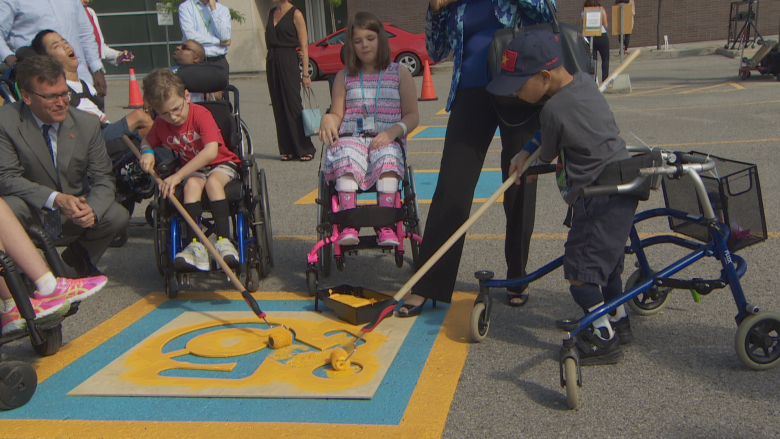'A forward moving perspective': Why one group is trying to update accessibility signs
It's universally recognizable – a figure sitting in a wheelchair against a blue background. It's the accessibility sign that has been used for years.
But accessibility activists in Ontario are pushing for a change.
They painted new signs Thursday featuring a person in motion using a wheelchair on parking spots at the Holland Bloorview Kids Rehabilitation Hospital.
This updated design was created by an American organization and is already used as the official accessibility sign in some U. S. states.
"The old one just shows someone sitting there and that's not really what we do. We move around," says Jillian Peters, who has cerebral palsy and uses a wheelchair to get around.
Peters and her mother Cheryl Peters were among a group of supporters who came out to paint the new signs.
The hospital's CEO, Julia Hanigsberg says it's about changing perspectives.
"Words matter, symbols matter and by changing this symbol we can actually send a message to thousands and thousands of people, thousands of times on what it means to be a person with a disability," Hanigsberg told CBC Toronto.
She says that the person is ancillary to the device in the old symbol, while the new symbol draws the person in control.
The hospital teamed up with an accessibility advocacy group, The Forward Movement, to paint the new signs in its parking lots. The group is lobbying the province to amend the Building Code and Highway Traffic Act to allow the use of the new design.
One of the movement's founders, Dylan Itzikowitz, says they're not trying to retroactively change the old signs. "We know how expensive that would be," he said. The group just wants the new design to be used from now on.
"We are painting what the province could look like in the future," said Maayan Ziv, another accessibility advocate who attended the event. "It's about looking at accessibility and people with disabilities with a more forward-moving perspective. We can do all sorts of things"
'She doesn't need fixing'
Cheryl Peters believes that a change in attitudes to surrounding disability is much needed. She says strangers have stopped her in a department store and asked if her daughter is seeing a doctor for "that," referring to her cerebral palsy.
"We have people that offer to pray over her and cure her," said Peters.
She thinks changing the design will help to people realize that a wheelchair is just a means of getting around for her daughter and that she is a happy, functional member of society.
"She doesn't need curing; she doesn't need fixing. She's not broken."





